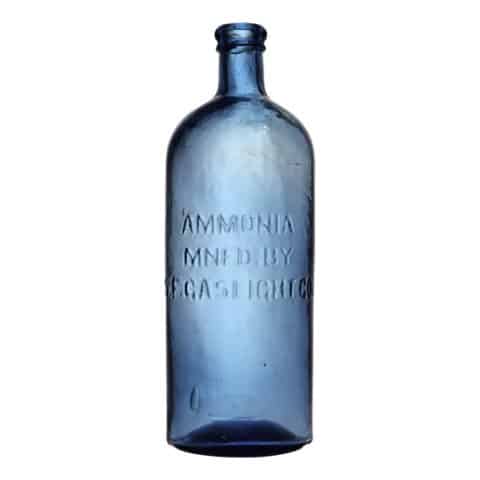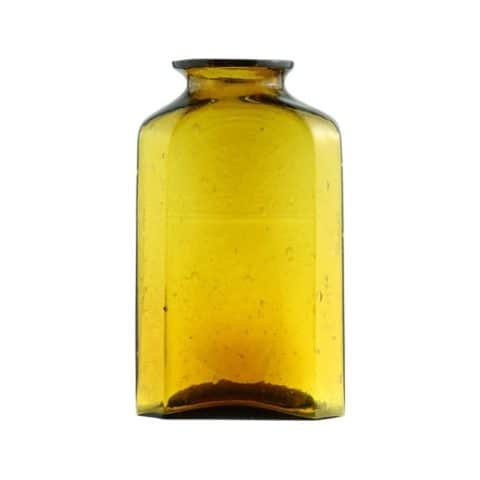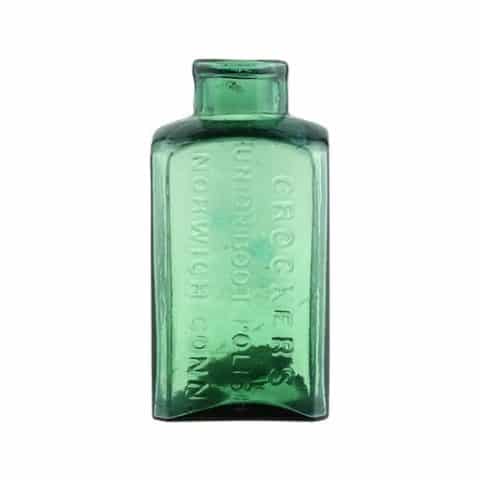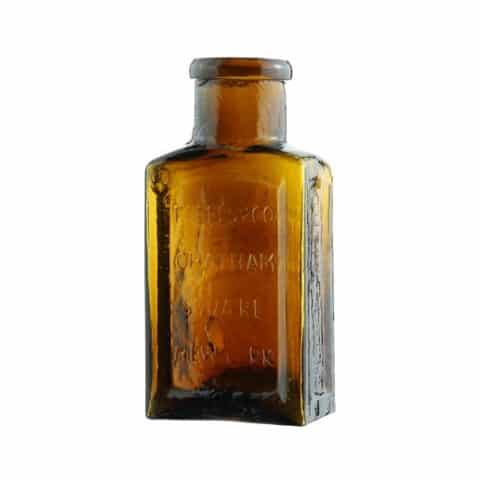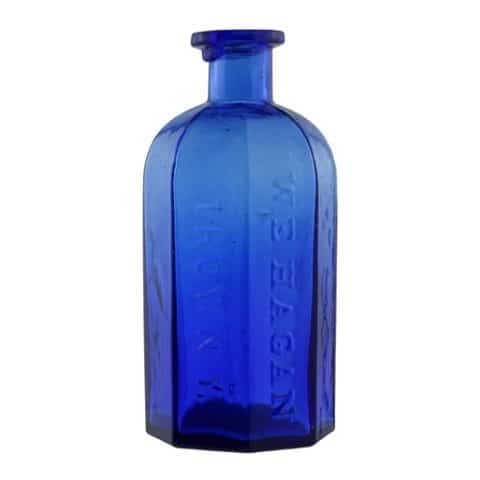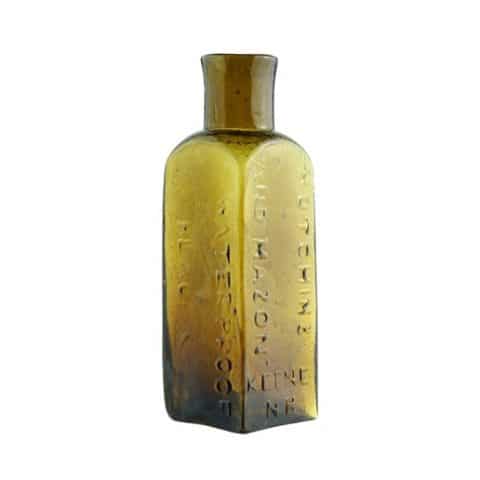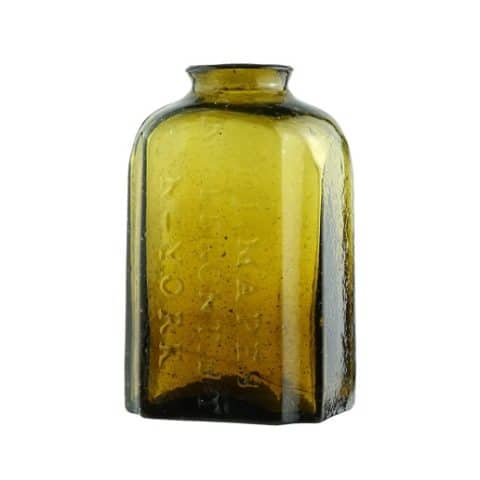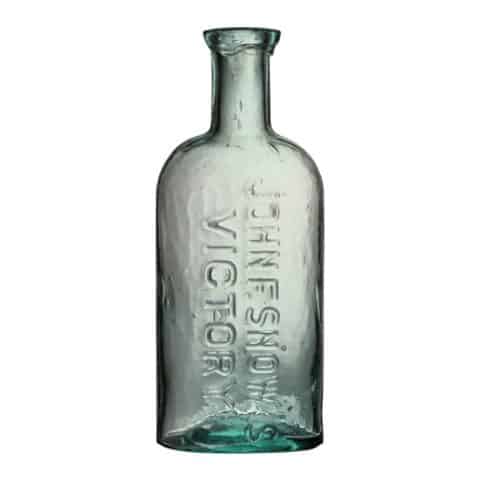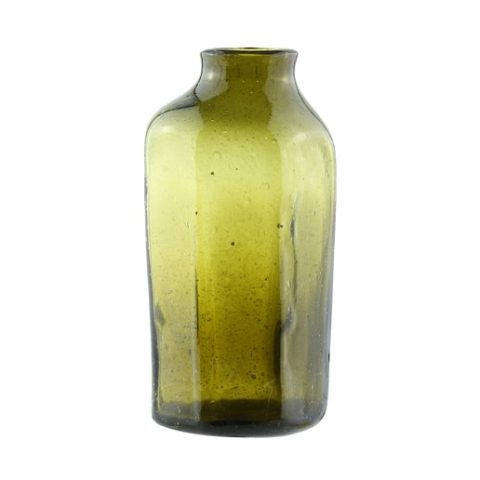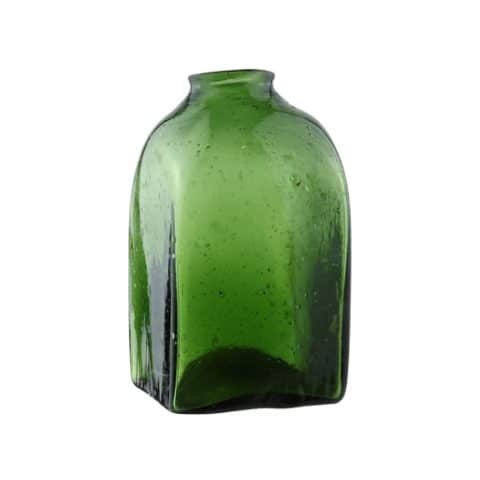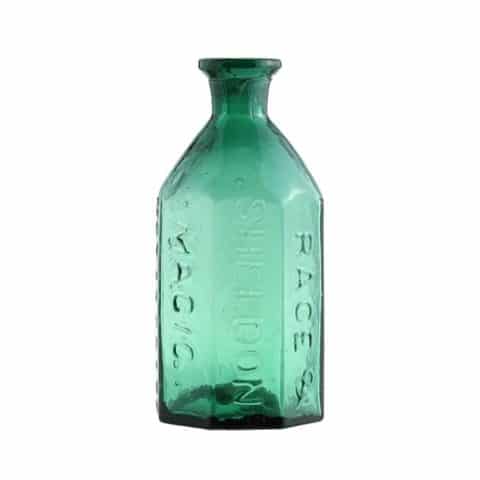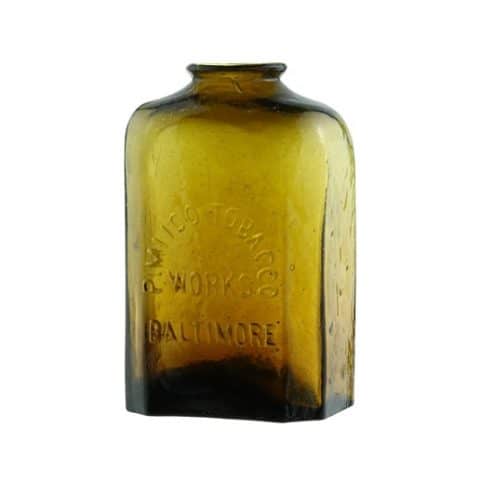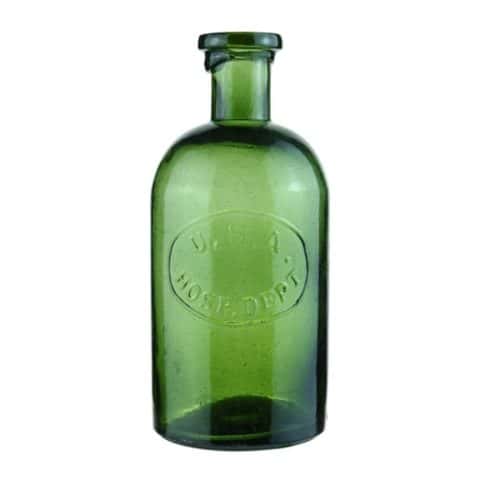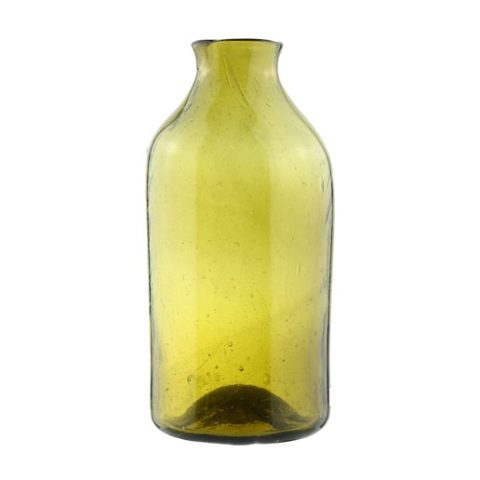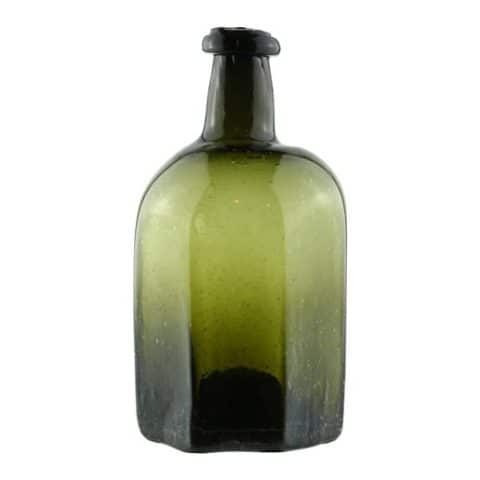Pimlico Tobacco Works Baltimore
Pimlico Tobacco Works Baltimore
Pimlico Snuff Mills and Tobacco Works, Baltimore County, Maryland
Forsyth & Cole, Proprietors, Baltimore, Maryland
Honey Amber Snuff Bottle
Provenance: Michael George Collection
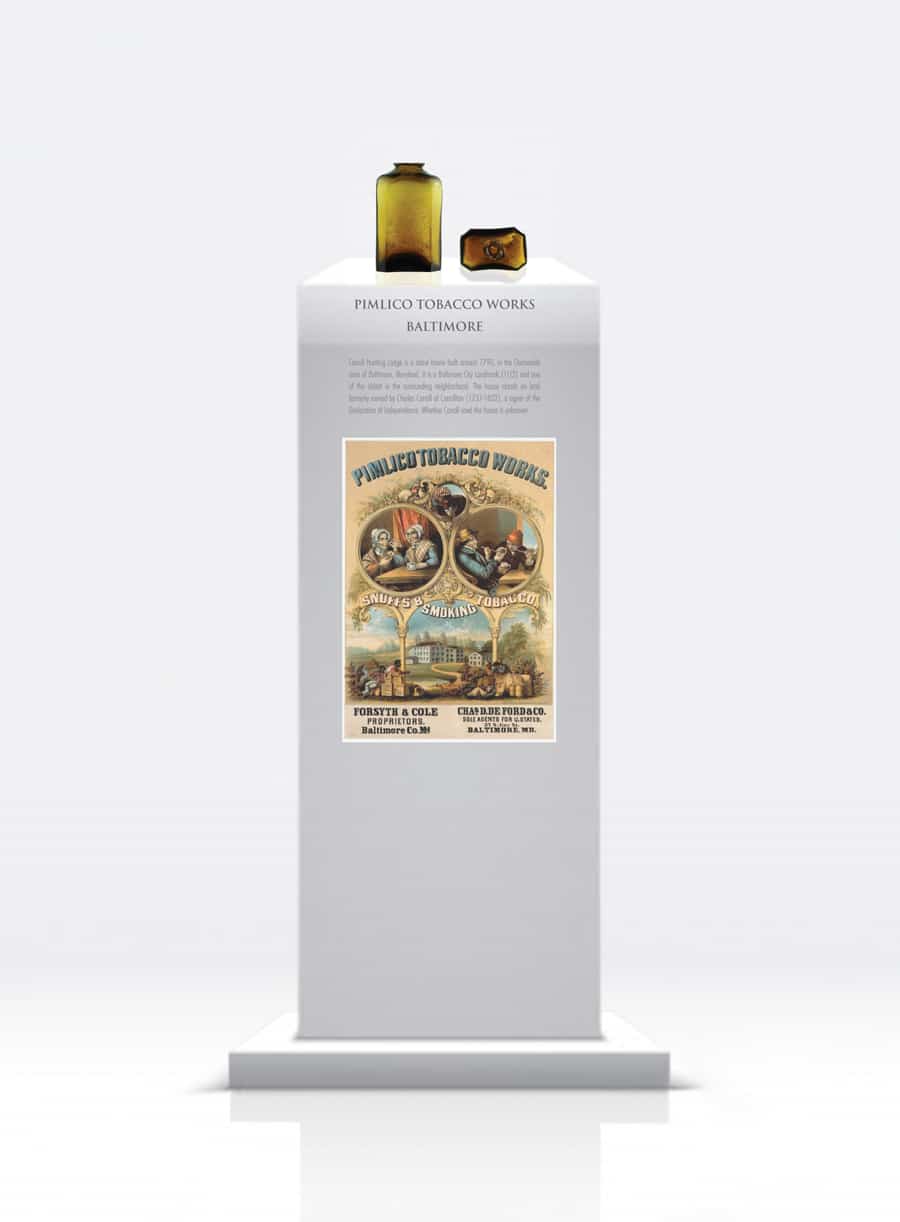
There is an interesting story behind this honey amber “Pimlico Tobacco Works Baltimore” snuff bottle which is quite exceptional. It was found in Texas on the side of a riverbank. Shards of this snuff bottle have been excavated around Baltimore, but there are very few, if any, known perfect examples.
The subject bottle is rectangular with wide beveled sides and rounded shoulders. Like most of these types of American snuff bottles, there is a short, almost nonexistent neck and a tooled rounded mouth. The bottle is embossed in three lines ‘PIMLICO TOBACCO’ (first line semi-circle convex arch), ‘WORKS’ (2nd line horizontal forming the inner base of the semi-circle), and ‘BALTIMORE’ (3rd line horizontal.) There is a very rough and pronounced jagged pontil on the bottom and a slight olive cast to the honey amber glass.
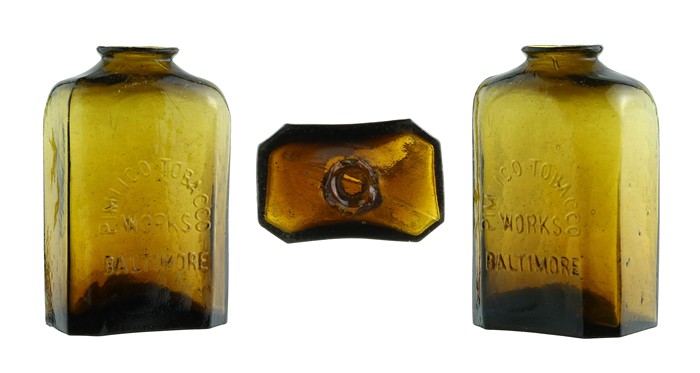
Along with grain, the growth of tobacco was the focus of the planters of Maryland from the earliest period of her colonial existence. Tobacco manufacturing and sales was a very early industry in Baltimore City and County with Thompson & Farish first advertising their store in 1766 and Fau Riufes, in 1789, at Bowley’s Wharf who was a commission merchant for the sale of leaf and manufactured tobacco. The very same year, Adrian Valck & Co. manufactured tobacco and Scotch snuff which was sold in bottles. Among other leading firms in the manufacture of smoking, fine-cut, chewing tobacco, and snuffs in the Baltimore area during the following years were A. & J. Bonn, Messrs. Gail & Ax, Marburg Bros., D. H. & L. V. Miller, B. F. Parlett & Co., J. D. Kremelberg, Forsyth & Cole, and R. Starr & Co., to name a few.
Manuel T. Forsyth and Lewis H. Cole, partners in Forsyth & Cole, were the proprietors of the Pimlico Snuff Mills and Tobacco Works in Baltimore County located in an area called the Western Run near the intersection of Greenspring Avenue and Pimlico Road. They started the operation in 1857 and were initially addressed at 72 Exchange Place in Baltimore City until they moved to No. 84 Fayette Street, three doors west of Charles Street. In 1860, they were selling snuff and smoking tobacco of all grades including Scotch Snuff and Maccoboy Snuff in barrels, kegs, jars, and bottles. Chas. D. De Ford & Co., 37 S. Gay Street, Baltimore were the Sole Agents for the United States. Our museum Pimlico Tobacco Works bottle was probably used for any number of Forsyth & Cole’s in-house snuff products. In 1861, one report stated that the concern manufactured 30,000 pounds of snuff.
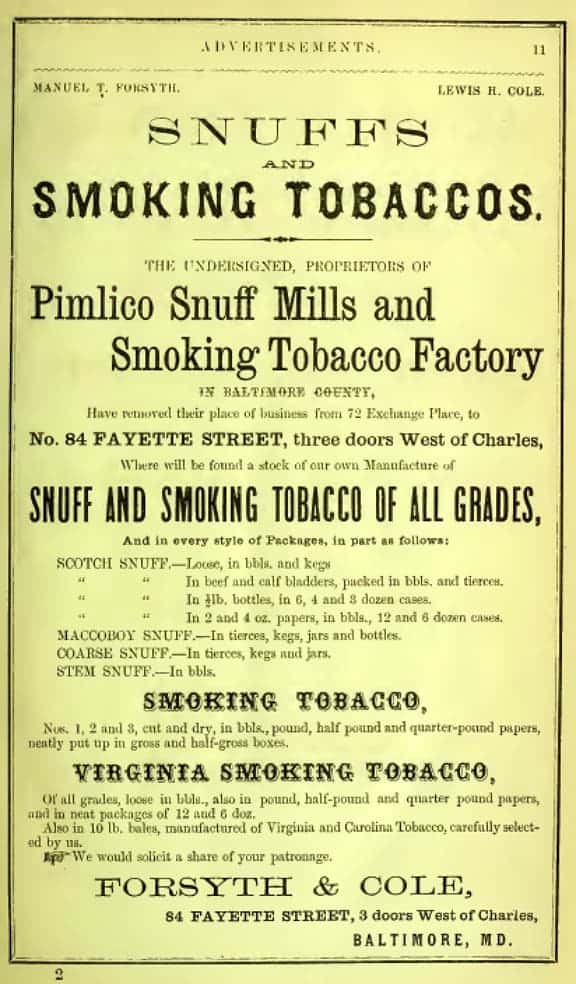
Pimlico Tobacco Works was located on a 1,200-acre tract owned by Charles Carroll who called it the “Labyrinth.” This name could also have been used for a stone house on the site which in historical records is referred to as the “Hunting Lodge.” The house and snuff mills construction is an excellent example of Maryland’s 18th-century vernacular architecture in its symmetry and simplicity. The heavy stone construction suggests how remote this area was, at that time, from the fashionable City of Baltimore.
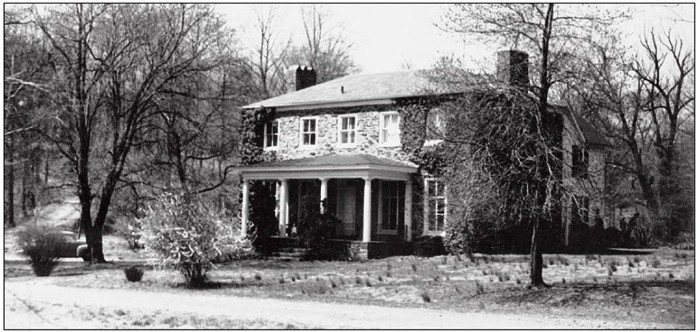
Charles Carroll was one of the four Maryland signers of the Declaration of Independence, a member of the General Assembly, a United States Senator, and a very wealthy landowner. There is no evidence that Carroll used the house as a hunting lodge, but it was likely used as the foreman’s house for Carroll who owned the mill at the time. From 1803 to 1809, the property was owned by Bernard Sourzac, one of several French immigrants from Haiti who settled in Mount Washington in the early 1800s.
There were newspaper notices in early 1864 indicating that Forsyth & Cole ceased to exist as creditors were given the notice to file their claims. The company was probably a victim of the Civil War. Manuel Forsyth would go on to work at snuff maker Gail & Ax after the war. The great flood of 1868 caused considerable damage to the Pimlico Tobacco Works rendering the site incompatible for manufacturing tobacco and snuff.
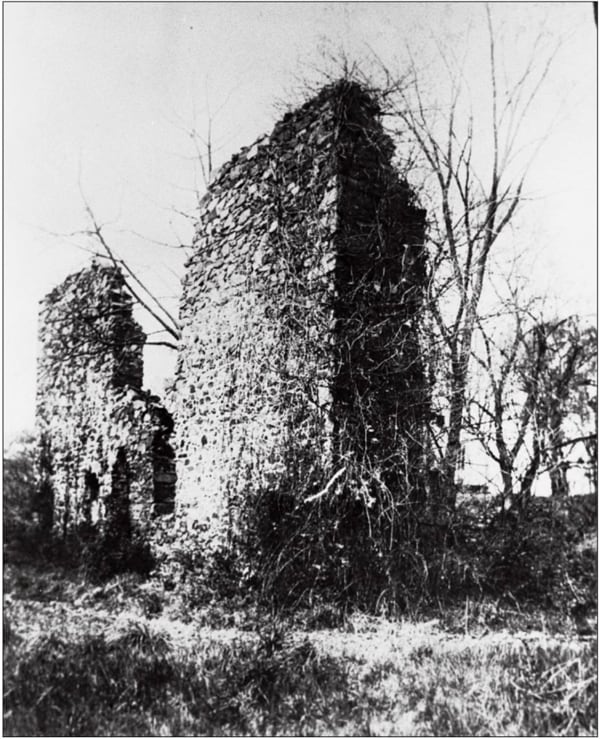
Snuff
Snuff was a fine dry product made at the mills of tobacco factories. The snuff was prepared in a form that could be held in the mouth for flavor extraction or sniffed or inhaled lightly after a pinch of snuff was either placed onto the back surface of the hand, held pinched between thumb and index finger, or held by a specially made “snuffing” device. If inhaled or sniffed into the nasal cavity, it would deliver a swift hit of nicotine and a lasting flavored scent, especially if flavoring had been blended with the tobacco. The first use of snuff is lost in time but documented as common by the indigenous residents of the Americas from the beginning of initial contact with Europeans in the late 1400s.
Snuff was produced when the leaves of tobacco were sorted and prepared with a sauce, which was different between manufactories. Typically it was composed of sugar, saltpeter, and sal ammonia, which was partially fermented. The leaves were then tied up in bunches, in which state they were most portable and better for preservation. The mass had to be carefully watched that it be not converted into humus. The whole was then ground in the mills, packaged, and sent to retailers.
During this early period in America, there were few Americans who used snuff, but many Germans and Frenchmen in the United States used it. There were different kinds manufactured, such a Maccoboy, Rappee, Lundy-foot, and Scotch snuff. There were other purposes in the Southern States where Scotch snuff was used such as to clean teeth or to excite a person’s gums after meals. Tons of snuff were shipped from Baltimore and New York to North Carolina and Georgia for this purpose. The snuff was also employed for destroying vermin on vines, plants, etc.
Pimlico
The London placename Pimlico probably has its origins in America and is linked with Sir Walter Raleigh’s abortive Roanoke settlements of the 1580s. The name is similar to Pamlico Sound, the belt of water enclosed by the chain of islands forming the Outer Banks in what is now North Carolina. This estuary has a crucial place in the history of America, for at its northern end is the island of Roanoke, where the abortive first English settlements of Raleigh’s Virginia were planted in 1585 and 1587. It receives, among others, the Pamlico River, generally now known as the Tar-Pamlico, which in turn takes its name from an extinct Native-American people (perhaps better recorded as the Pamticough) who lived along its banks.
Snuff Bottle Found
Our once rather dirty and scruffy snuff bottle was unearthed in Texas and was in the possession of a small historical society who were very excited to hear about how rare this bottle was. They had received the bottle from a local landowner who found it on the side of a riverbank. Instead of discarding the old bottle, the landowner gave it to the county’s historical society, and they didn’t have any information on the bottle. Since this Baltimore-marked bottle wasn’t a local historical item, they said it might be for sale who relayed the find to a northeast bottle club. Knowing the rarity of the item, the consignor made a generous offer, which seemed a little overwhelming to the society. The proposed transaction needed to be discussed with the board, and since the country was in the midst of a pandemic, this meeting had to wait. Eventually, a deal was struck and the bottle was shipped to New Hampshire. The package arrived in terrible shape but the bottle survived in a second interior box. We are pleased to have it represented in the museum.
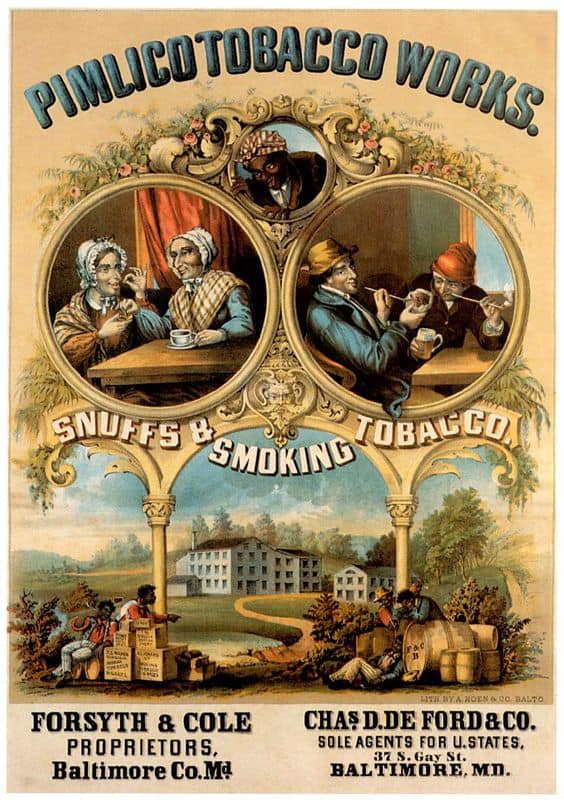
Primary Image: Pimlico Tobacco Works Baltimore snuff bottle imaged on location by Alan DeMaison, FOHBC Virtual Museum Midwest Studio
Support: Reference to History of Baltimore City and County, from the Earliest Period to the Present Day by John Thomas Scharf, 1881
Support: Reference to New England Review, A Couple of True Baltimore Survivors! by Michael George – Antique Bottle & Glass Collector
Support: Reference to The First American Placename in England: Pimlico by Richard Coates, University of Sussex
Support: Reference to Snuff and its Manufacture in Scientific American, November 1852
Support: Reference to Edward Roome – Tobacconist by Eric McGuire, Bottles and Extras, March – April 2017
Support: Reference to Bonn’s Pure Scotch Snuff – Baltimore, by Ferdinand Meyer V, Peachridgeglass.com
Support Image: Old Pimlico Snuff Mill ruins circa 1900 that once stood on Western Run near the intersection of Greenspring Avenue and Pimlico Road. – Photograph Collection of the Baltimore County Public Library
Support Image: Carroll Hunting Lodge, 1790. Once part of the Pimlico Tobacco Mills – Courtesy of the Mount Washington School
Join the FOHBC: The Virtual Museum is a project of the Federation of Historical Bottle Collectors (FOHBC). To become a member.


